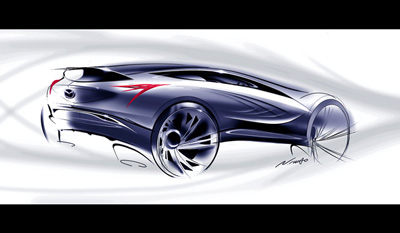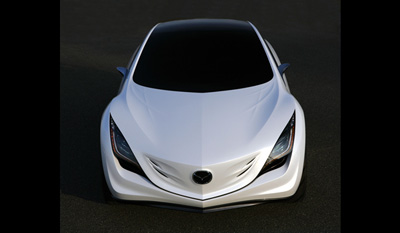MAZDA KAZAMAI CONCEPT 2008
The Mazda Kazamai Concept introduced at the 2008 Moscow Motor Show is the latest concept to be developed using the new Mazda design direction called Nagare, following in the footsteps of Nagare, Ryuga, Taiki or Furai concept vehicles. Nagare, which means "flow" in Japanese, represents a new approach to expressing movement in car design, taking as inspiration the flow patterns of natural elements, such as wind; Kazamai means "swirling crosswinds" in Japanese
Between 2004 and the end of 2007, Russia's automobile market grew by about 1.28 million cars, and in the process became Europe's second largest car market after Germany. One of the country's biggest segments is the sport utility vehicle (SUV), representing 16 percent of the total sales volume in 2007. Between 2004 and 2007, the segment became 10 times larger and this growth is expected to continue over the mid-term in Russia. The Mazda Kazamai concept car addresses the growing popularity of SUVs in Russia and gives a strong hint at where Mazda might be going with compact crossover SUV. Small , lightweight with dynamic styling, low-consumption using a next-generation Mazda powertrain, it is meant to appeal to young, upwardly-mobile Russians with a strong sense of style and urban lifestyle demands.
With a width of 1.930 mm and a length of 4.520 mm, it is slightly larger than the current Mazda 3, with room for SUV comfort and functionality on the inside. Yet, because it is only 1.500 mm high, has a flat roofline and very short rear overhangs, it also have sporty coupé look. The body design features flared fenders that emphasize SUV-like strength and a cabin befitting a sports car. The wedge-shaped profile was designed to evoke the image of a sleek arrow cutting through a mighty wind. In particular, the body design between the front wheel arches and the roof pillars is intended to express the agility and dynamism of wind gusting along the side of the vehicle. The panel lines on the sides represent swift and elegant crosswinds, further accentuating the dynamic and stylish body design. The bonnet itself is lower in the centre than on the sides, which emphasizes the car's powerful front fenders that accommodate large 22 inch wheels.
When Mazda set about reducing the bodyweight, they leveraged CAE applications and focused on four major areas: collision safety, handling , NVH, and strength. At the same time , lightweight materials and new processing/joining technologies were put to effective use. Aluminium or aluminium-alloy is used for the bonnet, the chassis and engine block. The designers aimed to make it 100 kilograms lighter than similar models by employing plastics for the panels, fenders and the engine cover.
 |
 |
The ideal match for the Mazda Kazamai concept would be a next-generation 2.0 litre direct-injection petrol engine, which Mazda engineers are currently developing. The engine will feature advanced technologies to minimize energy loss and vastly improved thermal efficiency. Mazda's next generation 2.0 litre Direct Injection Spark Ignition (DISI) petrol engine also has combustion control technology and valve control that deliver strong torque throughout the rev-range for excellent engine response as well as superior fuel economy. A next generation catalyst also ensures superior emissions performance. This is coupled to a lightweight and next generation compact six-speed automatic transmission that delivers the direct feel of a manual transmission, and four-wheel drive for superior traction. In combination with Kazamai's aerodynamics and its lightweight body, this powertrain is expected to deliver an estimated 30 percent improvement in fuel consumption and emissions (versus the current MZR 2.0 litre petrol engine) without compromising driving pleasure.
Wallpapers of the MAZDA KAZAMAI CONCEPT 2008
|